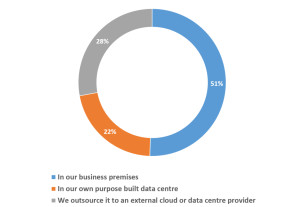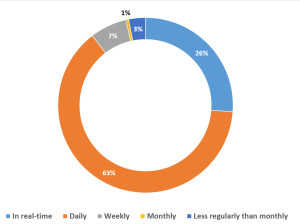O’Connor was unequivocal on these results.
“Sixty per cent of respondents said that it took longer than expected to recover data, which again is unacceptable for organisations that need to perform at optimum levels. Even more worryingly, the average time longer than expected to recover data was almost 36 hours or 1.5 days. These unexpected delays could have serious, negative consequences for organisations, particularly those sectors which are most reliant on data, such as financial services, insurance, legal and healthcare.
“That’s why any reputable business continuity provider will provide Recovery Time Objectives (RTOs) as part of their service, which set out an agreed maximum time limit whereby all essential data will be recovered,” said O’Connor.
The next question asked where data was kept, with just over half (51%) saying it was stored on their own premises. Just over one in five (22%) said data was stored primarily in their own purpose built data centre, and more than a quarter (28%) said that it was stored with an external cloud or data centre provider.
Respondents were then asked if a back-up copy of data was kept offsite. The majority (78%) said that a data back-up was held offsite at a secure location, while 12% confirmed off-site storage, but were unsure as to the security of the site. One in 10 said that a data back-up was not kept off-site.
“While it’s good to see that most respondents (78%) keep a copy of their data offsite and in a secure location, this question has still highlighted a significant minority (12%) are not doing this,” said O’Connor. “Ten per cent keep their back-up data onsite, which isn’t going to be of much help if the building goes on fire, is flooded or suffers a long term loss of power.
“Even more worrying is that 12% of respondents keep their backed up business data offsite but in a location that’s not secure. This would most likely imply that back-up tapes and disks are still in use and are not being securely stored. It’s quite possible that some business owners or employees are bringing tapes and disks home from the office at night or the weekend. While this was a popular practice once upon a time, particularly before better DR options existed, it’s no longer acceptable now.”
Back-up frequency was then probed, with just over a quarter (26%) backing-up in real time. The majority (63%) back-up daily, with 7% going weekly, 1% monthly and 3% not even doing monthly back-ups.
“Interesting to see that more than a quarter of organisations are now backing up data in real time,” O’Connor observed. “Continuous back-up as part of a Disaster Recovery as a Service (DRaaS) solution is becoming more attractive all the time. The main inhibitor to the adoption of DRaaS has primarily been bandwidth availability and speeds. As these continue to improve, particularly outside larger urban areas, so too will adoption of DRaaS. Also organisations that can identify and segment their most critical data will benefit by just replicating this essential data in the cloud in real-time.
“With the majority of organisations (63%) backing up their data once a day, this also meets the needs of many businesses.
“We would urge caution to the 11% of businesses that said they just back-up their data weekly, monthly or even longer. Are you sure that your business wouldn’t suffer serious consequences if you lost several days’ worth of data or even worse? The more regular the back-ups, the better and safer it is for your business, employees and customers,” said O’Connor.
Of the 78% who said that they backed-up offsite to a secure location, a further question was asked about testing the disaster recovery capability. Almost a third (32%) said that they did test, more than once a year. Almost the same (30%) said they tested it at least once a year, with just 9% testing every two years and 2% testing less than every two years. However, more than a quarter (27%) said that they did not test their disaster recovery capability.










Subscribers 0
Fans 0
Followers 0
Followers